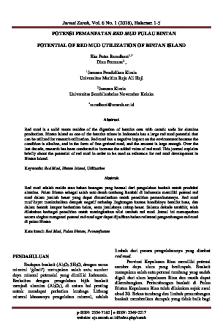Mud fossilization of soft tissues PDF

| Title | Mud fossilization of soft tissues |
|---|---|
| Author | Roger Spurr |
| Pages | 2 |
| File Size | 48.8 KB |
| File Type | |
| Total Downloads | 55 |
| Total Views | 86 |
Summary
MUD FOSSILIZATION OF SOFT TISSUE ABSTRACT: This work is about a previously UN-noticed soft tissue fossilization process. Dinosaur footprints are common in the Triassic rock of Central Ct. However a fossil bone or any other animal fossil has never been found in the wet soils of Ct. according to exper...
Description
MUD FOSSILIZATION OF SOFT TISSUE ABSTRACT: This work is about a previously UN-noticed soft tissue fossilization process. Dinosaur footprints are common in the Triassic rock of Central Ct. However a fossil bone or any other animal fossil has never been found in the wet soils of Ct. according to experts at Yale. 1...Fossils of soft tissue and bone are thought not to preserve well in wet soils. 2...Wet oxygenated porous soils will not preserve organic matter in "traditional" fossil form but instant anaerobic death in wet (electric) clay and microscopic platy polar silicates can create exquisite copies of the entire original creature in some cases. 3...Quick, cold, deep, fine mud in what was likely a mudslide appears to have encapsulated these specimens instantly and without oxygen. They simply cannot decompose and wash away when death comes in this manner. THESIS: Traditional fossils discussed... Most preserved bones are found in porous sand or soils which are primarily porous and dry. The soft tissues, skin, muscle, tendon, cartilage, organs etc are usually scavenged and or decomposed and quickly stripped of anything consumable by bugs and micro-organisms in porous oxygenated soils and sandy conditions. The decomposed organic matter becomes particles in the soil. In dry soil the central calcium bones are mineral and remain mostly intact. The result is the most basic bone structure with no organic fleshy detail. Mud fossils discussed... Mud fossils are virtual copies of the original creature (exactly like petrified trees). Blood and flesh are sometimes unable to escape in these type of mudslides due to compaction. In mud fossils, the bones do not have the mineralized spongy center look. The reason is ionic and nucleophilic invasion and conversion of calcium and phosphorous into other minerals. Primary invaders are ionic and OH- is often the major invader in deep mud fossil tissues. Natural electricity in wet soils discussed... The continuous wet soils generate "spontaneous electrical potentials".(1) These currents affect any materials with polarity. I call the process Mud fossil electrolysis... identical to plating cheap jewelry. These electric currents in the mud drive platy polar tiny crystals to invade the surface of highly reactive ionic soft tissue. The molecular sized tiny plates are flat and polarized. The electric current literally plates the soft tissue surface by electrolysis which changes the original material due to molecular bonding and nucleophilic substitution with invading chemicals. The result is like shingling a house and protecting the contents within. Skin is 50x more concentrated in silicon as other body parts. Silicon dioxide is exactly what covers many of the specimens, and that layer was tested 100% human mtDNA. Final report due in Sept 2015. Flesh turns to feldspar from electrolysis... Mineralization and crystallization creep in to voids created as VOCs sublimate out leaving metals seeds and carbon. Another similar process is plating cheap jewelry. I have done earth electrolysis experiments with chicken tissue in 12vdc and various soil substrates.(2) The results show amorphous quartz and various feldspar buildup. Feldspar consists of a conglomeration of amorphous layers of silicates attached to each other by crystal bonds. Once the surface of organic fleshy tissue is coated with these crystals, the process begins to restrict the molecular size allowed in. The plating becomes very restrictive of new invaders (actual molecular size). Finally H2O and OH- are so tiny they are allowed but almost nothing else larger. OH- is highly reactive to bone chemicals and renders them unrecognizable eventually after chemical reaction. Fascia a new science is discussed...
The body parts are separated by a fascia layer,(as they are when alive). After cold compacted death, this fascia preserves organ systems, blood vessels,and bodily fluids. This is because fascia and keratin are not water or enzyme soluble. UNINTERUPTED MOISTURE IS THE KEY TO PRESERVATION. Sharpys fibers are present with the reticular tissue penetrating fascia to bone. (3) Under the fascia is the periosteum layer. In the periosteum is a layer of soft tissue including the tendon sockets and ligament sockets and blood vessels and canaliculus and lacunae which are "soft tissues" and are normally gone in dry mineral fossils. The fascia fabric protects soft tissue in distinct packages (organs, tendons etc) and may be broken up along these fascial planes during glacial tilling resulting in "body parts". ------METHODS... This research was done by Roger Spurr an independent researcher in Middletown Ct. over the course of several years. [email protected] ------CONCLUSION... Soft tissue preservation is possible in wet molecular sized silicates, basically very fine clay and mud. The finer and deeper and colder and quicker the encapsulation the better the preservation. The continuously wet soils generate "spontaneous electric potentials". The polarity of tiny crystals under electric influences react vigorously with ionic organic matter. Electrolysis is the catalyst using platy polar silicates and percolates in the wet soil as the electrolyte. The crystals coat and seal the surface of organic tissues. Silicon "I believe" and also Iron in blood (FE2 and FE3) is the known soft tissue preservation agent.(2) In this case, the blood with iron is not washed away and may be the source of this exceptional preservation as lungs appear to preserve exceptionally well. ------REFERENCES... (1) http://www.glossary.oilfield.slb.com/en/Terms/s/spontaneous_potential.aspx (2) http://www.livescience.com/41537-t-rex-soft-tissue.html (3) https://books.google.com/books?id=9pzyCAAAQBAJ&pg=PA60&lpg=PA60&dq=sharpey %27s+fibers+vs+reticular+fibers&source=bl&ots=3hmZyWohPa&sig=aFJhyWcQm81hMvuutUEDad V4eYc&hl=en&sa=X&ved=0CCgQ6AEwAWoVChMIwqqlvK2FxgIVQS6sCh2P1wA8#v=onepage& q=sharpey's%20fibers%20vs%20reticular%20fibers&f=false...
Similar Free PDFs

Histology of Tissues Chart-2
- 7 Pages

Fascia Facilitated Fossilization
- 2 Pages

MAKALAH soft skill
- 13 Pages

SOFT HARD SKILL
- 9 Pages

Soft System Methodology
- 31 Pages

Riassunto libro Soft Skills
- 26 Pages

Worksheet - tissues chart
- 1 Pages

THESIS SOFT COPY
- 34 Pages
Popular Institutions
- Tinajero National High School - Annex
- Politeknik Caltex Riau
- Yokohama City University
- SGT University
- University of Al-Qadisiyah
- Divine Word College of Vigan
- Techniek College Rotterdam
- Universidade de Santiago
- Universiti Teknologi MARA Cawangan Johor Kampus Pasir Gudang
- Poltekkes Kemenkes Yogyakarta
- Baguio City National High School
- Colegio san marcos
- preparatoria uno
- Centro de Bachillerato Tecnológico Industrial y de Servicios No. 107
- Dalian Maritime University
- Quang Trung Secondary School
- Colegio Tecnológico en Informática
- Corporación Regional de Educación Superior
- Grupo CEDVA
- Dar Al Uloom University
- Centro de Estudios Preuniversitarios de la Universidad Nacional de Ingeniería
- 上智大学
- Aakash International School, Nuna Majara
- San Felipe Neri Catholic School
- Kang Chiao International School - New Taipei City
- Misamis Occidental National High School
- Institución Educativa Escuela Normal Juan Ladrilleros
- Kolehiyo ng Pantukan
- Batanes State College
- Instituto Continental
- Sekolah Menengah Kejuruan Kesehatan Kaltara (Tarakan)
- Colegio de La Inmaculada Concepcion - Cebu







